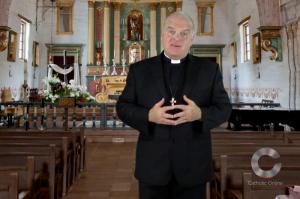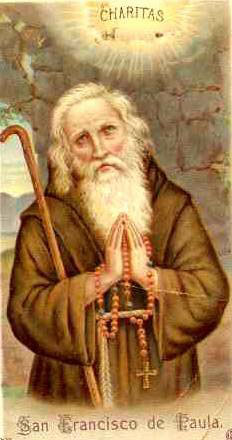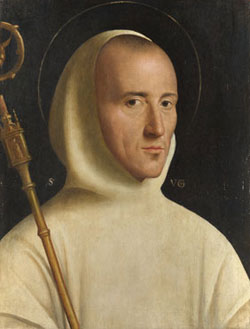Abbey of Savigny
FREE Catholic Classes
Situated on the confines of Normandy and Brittany, Diocese of Coutances, France. Founded by Vital de Mortain, Canon of the Collegiate Church of St. Evroul, who, resigning his prebend to embrace an eremitical life under Robert of Arbrissel in the forest of Craon (Anjou), and leaving the latter, retired to the forest of Savigny (1105), where he built a hermitage. Soon, however, the number of disciples who gathered around him necessitated the construction of adequate buildings, in which was instituted the monastic life, following the Rule of St. Benedict, and interpreted in a manner similar to the Cistercians. Rudolph, lord of Fougeres, confirmed to the monastery (1112) the grants he had formerly made to Vital, and from then dates the foundation of the monastery. Once firmly established, its growth was rapid, and it soon became one of the most celebrated in France. Its founder was judged worthy of canonization, and many of his successors in the abbatial office, as well as simple religious of the Abbey, were canonized or beatified by the Church ; the best known of them being St. Aymon. From the number of its foundations Savigny became the head of a Congregation, numbering thirty-three subordinate houses, within thirty years of its own inception. In 1119 Pope Celestine II, then in Angers, took it under his immediate protection, and strongly commended it to the neighbouring nobles. Under Geoffroy, successor to Vital, Henry I, of England, established and generously endowed twenty-nine monasteries of this Congregation in his dominions. St. Bernard also held them in high esteem, and it was at his request that their monks, in the troubled times of the antipope Anacletus, declared in favour of Pope Innocent II. Serlon, third successor of the Founder, found it difficult to retain his jurisdiction over the English monasteries, who wished to make themselves independent, and so determined to affiliate the entire Congregation to Cîteaux, which was effected at the General Chapter of 1147. Several English monasteries objecting to this, were finally obliged to submit by Pope Eugene III (1148). Little by little discipline became relaxed, and commendatory Abbots being introduced (1501) it never regained its first greatness. In 1509 it was pillaged and partly burned by the Calvinists, and records of the following year mention but twenty-four monks remaining. It continued to exist until the Revolution reduced it to a heap of ruins, and scattered its then existing members. The church, a model of Cistercian architecture, was restored in 1869, and now serves for parish purposes. Of all its former dependencies, there remains only La Grande Trappe. This, though not founded directly was a daughter of the Abbey of Breuil-Benoit, which latter was a direct filiation of Savigny.
Join the Movement
When you sign up below, you don't just join an email list - you're joining an entire movement for Free world class Catholic education.

-

- Stations of the Cross
- Easter / Lent
- 5 Lenten Prayers
- Ash Wednesday
- Living Lent
- 7 Morning Prayers
- Mysteries of the Rosary
- Litany of the Bl. Virgin Mary
- Popular Saints
- Popular Prayers
- Female Saints
- Saint Feast Days by Month
- Pray the Rosary
Pope Francis’ April Prayer Intention: Using Technology to Strengthen Human Connections
Finding Peace Through Prayer in a World of Worry
Trump Administration Withholds Federal Grants from Planned Parenthood Over DEI and Civil Rights Concerns
Daily Catholic
 Daily Readings for Wednesday, April 02, 2025
Daily Readings for Wednesday, April 02, 2025 St. Francis of Paola: Saint of the Day for Wednesday, April 02, 2025
St. Francis of Paola: Saint of the Day for Wednesday, April 02, 2025 Prayer for God's Help in Daily Actions: Prayer of the Day for Friday, March 14, 2025
Prayer for God's Help in Daily Actions: Prayer of the Day for Friday, March 14, 2025 Daily Readings for Tuesday, April 01, 2025
Daily Readings for Tuesday, April 01, 2025 St. Hugh of Grenoble: Saint of the Day for Tuesday, April 01, 2025
St. Hugh of Grenoble: Saint of the Day for Tuesday, April 01, 2025- To Perceive Animals as God's Gifts: Prayer of the Day for Thursday, March 13, 2025
![]()
Copyright 2025 Catholic Online. All materials contained on this site, whether written, audible or visual are the exclusive property of Catholic Online and are protected under U.S. and International copyright laws, © Copyright 2025 Catholic Online. Any unauthorized use, without prior written consent of Catholic Online is strictly forbidden and prohibited.
Catholic Online is a Project of Your Catholic Voice Foundation, a Not-for-Profit Corporation. Your Catholic Voice Foundation has been granted a recognition of tax exemption under Section 501(c)(3) of the Internal Revenue Code. Federal Tax Identification Number: 81-0596847. Your gift is tax-deductible as allowed by law.


 Daily Readings for Wednesday, April 02, 2025
Daily Readings for Wednesday, April 02, 2025 St. Francis of Paola: Saint of the Day for Wednesday, April 02, 2025
St. Francis of Paola: Saint of the Day for Wednesday, April 02, 2025 Prayer for God's Help in Daily Actions: Prayer of the Day for Friday, March 14, 2025
Prayer for God's Help in Daily Actions: Prayer of the Day for Friday, March 14, 2025 St. Hugh of Grenoble: Saint of the Day for Tuesday, April 01, 2025
St. Hugh of Grenoble: Saint of the Day for Tuesday, April 01, 2025

